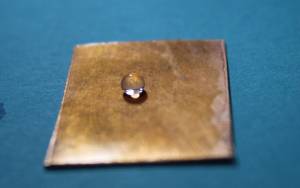Water- and dirt-repellent sportswear and outdoor clothing, or anti-fog windshields – there are many everyday products that can profit from highly hydrophobic coatings. For such coatings, researchers led by Dr. Bastian E. Rapp at Karlsruhe Institute of Technology (KIT) have created Fluoropor, a material that is both transparent and abrasion-resistant and that consists of a fluorinated polymer foam with continuous nano/micro-structure. Fluoropor is presented in Nature Scientific Reports. (DOI: 10.1038/s41598-017-15287-8)
Water droplets run off the leaf surface: In nature, this phenomenon is mainly known from lotus plants. Researchers imitate this lotus effect by means of superhydrophobic i.e., highly water-repellent, surfaces. At KIT, the team of Dr. Bastian E. Rapp at the Institute of Microstructure Technology (IMT) develops a new class of such materials called Fluoropor. The researchers combine the properties of fluoropolymers i.e., plastics with a degree of fluorination, with the roughness known from lotus leaves. In this way, they obtain surfaces that are both oil- and water-repellent. The new materials are characterized by a high chemical and thermal stability. Together with researchers from the Institute for Applied Materials – Computational Materials Science (IAM-CMS), the researchers in Dr. Rapp’s junior research group NeptunLab succeeded for the first time in developing a fluorinated polymer foam which, in addition, is transparent and insensitive to abrasion. This material, called Fluoropor, is introduced in Nature Scientific Reports.
Superhydrophobic properties develop due to structuring on the nano/microscale. Such extremely fine structures (one nanometer is a billionth of a meter) make surfaces highly sensitive to abrasion and account for the fact that they are not sufficiently robust for everyday applications. In the case of Fluoropor, in contrast, the nano-/microstructure is not limited to the surface but occurs throughout the material, thus giving the material a high long-term abrasion resistance and suitability for daily use. The foam seems optically transparent due to its tiny pores whose diameter is below the wavelength of visible light. Fluoropor, therefore, is ideally suited as a coating for transparent substrates such as glass. The material, can, however, also be applied to e.g., metal, polymers, or textiles.
Fluoropor can be efficiently manufactured in one step in different thicknesses by so-called photo-induced radical polymerization. The development of Fluoropor is funded by the Federal Ministry of Education and Research within the program NanoMatFutur.
Dorothea Helmer, Nico Keller, Frederik Kotz, Friederike Stolz, Christian Greiner, Tobias M. Nargang, Kai Sachsenheimer & Bastian E. Rapp: Transparent, abrasion-insensitive superhydrophobic coatings for real-world applications. Nature Scientific Reports 7, Article number: 15078 (2017). DOI: 10.1038/s41598-017-15287-8
Further reading:
Nature Scientific Reports:
https://www.nature.com/articles/s41598-017-15287-8
In close partnership with society, KIT develops solutions for urgent challenges – from climate change, energy transition and sustainable use of natural resources to artificial intelligence, sovereignty and an aging population. As The University in the Helmholtz Association, KIT unites scientific excellence from insight to application-driven research under one roof – and is thus in a unique position to drive this transformation. As a University of Excellence, KIT offers its more than 10,000 employees and 22,800 students outstanding opportunities to shape a sustainable and resilient future. KIT – Science for Impact.

